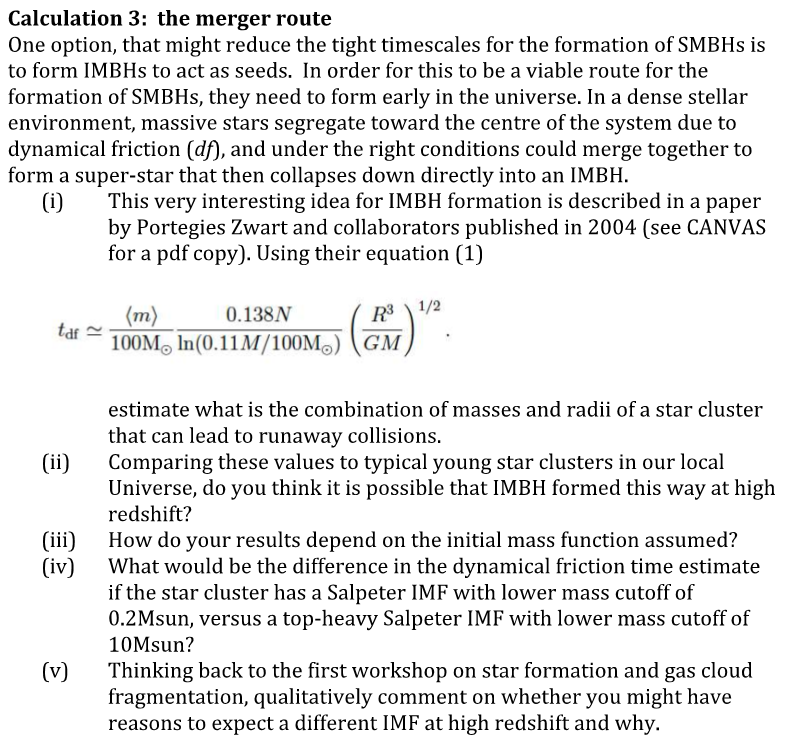
Calculation 3: the merger route One option, that might reduce the tight timescales for the formation of SMBHs is to form IMBHs to act as seeds. In order for this to be a viable route for the formation of SMBHs, they need to form early in the universe. In a dense stellar environment, massive stars segregate toward the centre of the system due to dynamical friction (df), and under the right conditions could merge together to form a super-star that then collapses down directly into an IMBH. (i) This very interesting idea for IMBH formation is described in a paper by Portegies Zwart and collaborators published in 2004 (see CANVAS for a pdf copy). Using their equation (1) / R3 1/2 tai 10 (m) 0.138N 100M. In(0.11 M/100M.) (ii) (iii) (iv) estimate what is the combination of masses and radii of a star cluster that can lead to runaway collisions. Comparing these values to typical young star clusters in our local Universe, do you think it is possible that IMBH formed this way at high redshift? How do your results depend on the initial mass function assumed? What would be the difference in the dynamical friction time estimate if the star cluster has a Salpeter IMF with lower mass cutoff of 0.2 Msun, versus a top-heavy Salpeter IMF with lower mass cutoff of 10Msun? Thinking back to the first workshop on star formation and gas cloud fragmentation, qualitatively comment on whether you might have reasons to expect a different IMF at high redshift and why. (v) Calculation 3: the merger route One option, that might reduce the tight timescales for the formation of SMBHs is to form IMBHs to act as seeds. In order for this to be a viable route for the formation of SMBHs, they need to form early in the universe. In a dense stellar environment, massive stars segregate toward the centre of the system due to dynamical friction (df), and under the right conditions could merge together to form a super-star that then collapses down directly into an IMBH. (i) This very interesting idea for IMBH formation is described in a paper by Portegies Zwart and collaborators published in 2004 (see CANVAS for a pdf copy). Using their equation (1) / R3 1/2 tai 10 (m) 0.138N 100M. In(0.11 M/100M.) (ii) (iii) (iv) estimate what is the combination of masses and radii of a star cluster that can lead to runaway collisions. Comparing these values to typical young star clusters in our local Universe, do you think it is possible that IMBH formed this way at high redshift? How do your results depend on the initial mass function assumed? What would be the difference in the dynamical friction time estimate if the star cluster has a Salpeter IMF with lower mass cutoff of 0.2 Msun, versus a top-heavy Salpeter IMF with lower mass cutoff of 10Msun? Thinking back to the first workshop on star formation and gas cloud fragmentation, qualitatively comment on whether you might have reasons to expect a different IMF at high redshift and why. (v)







